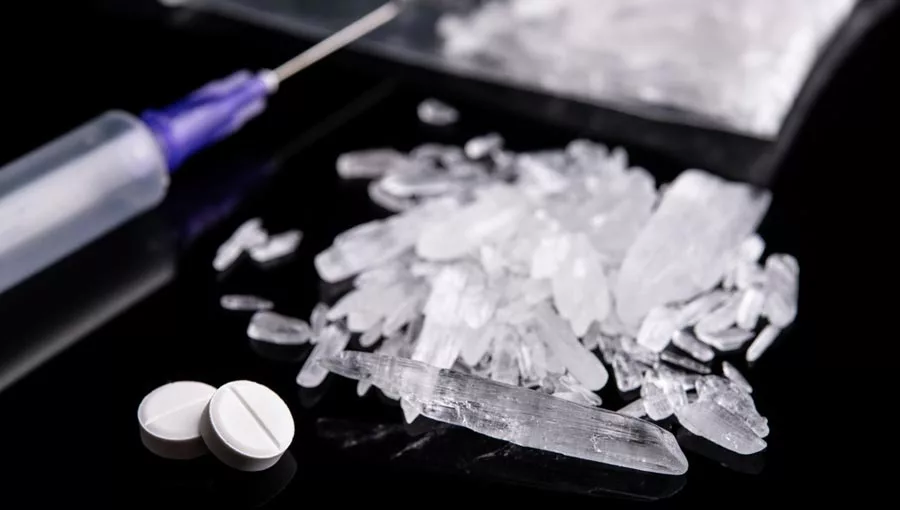Get Stimulant Info and Support Options at South Shores
With the creation and adoption of so many different drugs, analogs, and designer substances – it’s difficult to keep up with and discern certain substances from one another. For example – a synthetic version of any drug can be created in a lab – giving it nearly the same chemical makeup as its counterpart – in turn, triggering the same mental and physical effects when the user experiences the high.
However, some analogs are more dangerous than their originals, and users are getting ahold of substances that are causing adverse reactions with the intention of ingesting a completely different narcotic.
One of the earliest cases of this type of relationship is potentially the widespread availability of amphetamine and methamphetamine. Many people consider the two to be the same substance. However, this couldn’t be further from the truth. Let’s take a close look at meth vs amphetamine use now.
If you or someone you know is battling a speed addiction, this resource from South Shores Detox and Recovery will provide insight into the specifics of the two most popular stimulant drugs on the market.
Prescription Amphetamines and Crystal Meth
Methamphetamine and amphetamine, two potent stimulants with closely related chemical structures, often find themselves at the center of discussions surrounding drug use, addiction, and their impact on individuals and society.
Both substances are known for their ability to increase alertness, energy, and concentration, making them popular choices among those seeking heightened performance or a recreational high.
However, beneath their surface similarities lie important distinctions in terms of effects, medical uses, legal status, and potential risks. Let’s take a look at a comparative analysis of methamphetamine and amphetamine, shedding light on their chemical composition, historical context, legal regulations, and the varied ways they impact the human body and mind.
Amphetamines vs Methamphetamines: Chemical Makeup
Methamphetamine and amphetamine are both classified as psychoactive stimulant drugs, and their chemical structures play a significant role in their effects on the human body and mind. Methamphetamine, also known as “crystal meth,” is scientifically named N-methyl-1-phenylpropan-2-amine.
It consists of a phenyl ring, a methyl group, and a chiral center, which gives rise to two enantiomers (mirror-image forms), with one being more potent and associated with its psychoactive effects – or in other words, the half that manifests the high you feel when ingested.
Amphetamine, on the other hand, has a similar basic structure, scientifically referred to as alpha-methylphenethylamine. Instead of a phenylpropan element, the core structure comprises a phenethylamine foundation with a methyl group attached to the alpha carbon. This seemingly subtle difference in structure results in the primary differences in properties and effects.
Key Similarities and Differences in Their Chemical Makeup
Despite their structural similarities, the key differences between amphetamine and methamphetamine lie in their potency, length of action, and overall effects. Methamphetamine, being more lipid-soluble due to the additional methyl group, penetrates the blood-brain barrier at a much higher rate than its counterpart. This leads to a longer window of effectiveness and a more pronounced impact on the central nervous system.
Alternatively, amphetamine has a much shorter window of impact and is usually considered much weaker. These contrasts in the construction translate into differences in how the human body and mind receive the effects of these stimulant drugs.
The History of Amphetamines vs. Methamphetamines
You have to go all the way back to the turn of the 19th century to find the roots of amphetamine. Chemist Lazar Edeleanu of Romania synthesized a compound that would be considered an analog of amphetamine.
It wasn’t until the early 1900s that the effects of this compound on the central nervous system were recognized. By the 1920s, the compound was developed into a substance known as Benzedrine and was used for medical and non-medical purposes. What about methamphetamine?
Methamphetamine Discovery
Methamphetamine is technically produced as a derivative of amphetamine. The former was unveiled in the 1900s when Nagai Nagayoshi was able to successfully accomplish a full synthesis. The impact was further tested during World War 2 when both the Axis and Allied sides used the drug to stay awake for extended hours during combat.
When the war was over, meth became widely available in multiple forms but eventually found its way to the black market because of its euphoric effects.
From Miracle Cures to Scheduled Drugs of Abuse
The continuous research and development of these drugs led to noticeable benchmarks throughout the history of medicine. Initially, medications containing amphetamine were created and marketed to remedy narcolepsy and attention deficit hyperactivity disorder, otherwise known as ADHD.
The subsequent abuse of each drug led to legal control and scheduling. Both were designated as Schedule II due to their potential for addiction.
Medicines like Adderall and Dexedrine are primarily made up of amphetamines and used in the treatment of certain disorders mentioned above, providing an increase of focus and attention. Methamphetamine, on the other hand, has typically been limited in medical applications because of its intensity and potential for abuse.
In certain geographic locations, the drug is legal and written as a prescription for weight loss.
The Abuse of Amphetamines as Prescription Medications
These two drugs are distinct in the fact that prescription amphetamines or other prescription stimulants are ingested and abused differently than crystal meth.
Amphetamine is available in many formulations and is generally abused for its stimulant properties. These prescription stimulants such as Adderall or Ritalin may be obtained through a prescription but are generally acquired on the black market. Prescription amphetamine is popular among college students and athletes who need additional energy or avoid sleep.
Typically, these substances are taken orally, snorted, and on rare occasions, may be injected.
Meth as an Illicit Street Drug: Recreational Crystal Meth and Meth Addiction
Methamphetamine, otherwise known as meth or crystal, has seen an explosion in use over the last five years. This drug normally comes in a white or clear crystal form and is odorless. Most users who engage in substance abuse involving meth either smoke, snort, or injected.
Either option causes an intense high and extended periods of remaining awake.
Impact of Methamphetamine and Amphetamines On the Mind and Body
Both of these prescription drugs impact the central nervous system. They’re responsible for the release of neurotransmitters, typically dopamine and norepinephrine, leading to the alert and euphoric feeling.
However, methamphetamine’s impact is usually far more intense and lasts longer than prescription amphetamines. This increased potency usually results in a far greater addiction risk, which, ultimately, ends with adverse health challenges.
Prescription amphetamines are also addictive but produce milder and shorter-acting effects.
Legalities of Meth vs Amphetamines
The specifics of the laws surrounding these two drugs vary depending on your geographic location. Prescription amphetamines are considered a controlled substance in most countries. The Schedule II designation means the drug is accepted for medical purposes but also carries a significant risk of addiction.
Methamphetamine is classified in the same manner. However, there are generally far stiffer penalties for the possession, distribution, and manufacturing of methamphetamine, or crystal meth.
Health Risks of These Central Nervous System Stimulant Drugs
The long-term abuse of either of these drugs leads to amphetamine use disorder or methamphetamine use disorder. Both come with a variety of different severe health problems if the user doesn’t refrain or seek help. Some of the most common challenges include:
- Increased heart rate
- High blood pressure
- anxiety
- Insomnia
- Psychosis and other mental health challenges
Extended amphetamine use disorder leads to extreme weight loss – and eventually causes withdrawal symptoms once a user refrains from use. The intensity of withdrawal symptoms depends on the length of use and whether the drug of choice is amphetamine or methamphetamine.
As a general rule, methamphetamine carries far more severe consequences all the way around – legally, physically, mentally, and medically.
Treatment for Stimulant Withdrawal Symptoms and Addiction
In certain cases, medical detox is required for meth addiction. This is heavily dependent on the length of use and the potency of the drug. However, one of the more common results is the manifestation of intense mental challenges like psychosis.
Users eventually experience full-blown delusions with hallucinations and extreme paranoia. This is what’s known as meth psychosis, and is very common, especially with the current chemical makeup of most meth on the streets.
The primary avenue of treatment typically consists of either medical detox or a stay in a mental health ward, followed by a 30, 60, or 90 day inpatient treatment program.
Inpatient Treatment and Outpatient Stepdown Programs
Meth withdrawal generally lasts anywhere from one week to a month. When the detox period is over, clients are cleared to participate in inpatient or outpatient treatment. Therapy normally consists of a variety of different methods, depending on the personalized treatment plan the client and their team create.
Behavioral therapies are generally effective at combatting meth addiction gradually, along with group therapy and holistic practices. The user may experience severe depression, even long after abstinence, due to the depletion of neurotransmitters in the brain.
However, with continued counseling and potential prescription therapy in the form of antidepressants, users can expect a full recovery with a good attitude and strong effort.
South Shores Detox: Get Options for Meth Recovery Now
South Shores Detox is well-versed in the treatment of amphetamine and methamphetamine addiction. With a professional team of licensed mental health and addiction specialists, along with a state-of-the-art facility, long-term recovery is a real possibility for those suffering from addiction to either substance.
For more information on how we can help you make a full recovery, contact our admissions team today!






